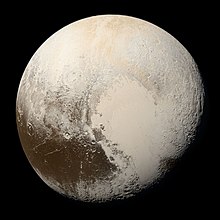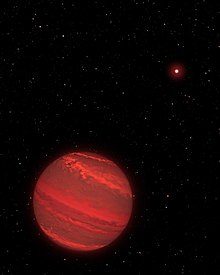Planetary-mass object
Cases in which the term is often used: The three largest satellites Ganymede, Titan, and Callisto are of similar size or larger than the planet Mercury; these and four more – Io, the Moon, Europa, and Triton – are larger and more massive than the largest and most massive dwarf planets, Pluto and Eris.Another dozen smaller satellites are large enough to have become round at some point in their history through their own gravity, tidal heating from their parent planets, or both.[11] A dwarf planet is a planetary-mass object that is neither a true planet nor a natural satellite; it is in direct orbit of a star, and is massive enough for its gravity to compress it into a hydrostatically equilibrious shape (usually a spheroid), but has not cleared the neighborhood of other material around its orbit.The International Astronomical Union (IAU) accepted the term (rather than the more neutral 'planetoid') but decided to classify dwarf planets as a separate category of object.Single and multiple planets could be captured into arbitrary unaligned orbits, non-coplanar with each other or with the stellar host spin, or pre-existing planetary system.


PlanetProteusNereidDysnomiageophysical definition of celestial objectscelestial objecthydrostatic equilibriumplanetsdwarf planetsplanetary-mass satellitesfree-floating planetsrogue planetssub-brown dwarfsisolated planetary-mass objectsNGC 1333VHS 1256-1257 bBD+60 1417bPlanetary-mass moonGanymedeCallistoMercurythe MoonEuropaTritonmethaneDwarf planetNew HorizonsAlan SternInternational Astronomical Unionroundedastronomical bodystellar remnantbrown dwarfSolar Systemterrestrial planetsgiant planetsJupiterSaturnUranusNeptunenebular hypothesisinterstellar cloudnebulaprotostarprotoplanetary diskgravityaccretionbinary starAccretion-powered pulsarsPSR J1719−1438helium planetcarbon planetSub-brown dwarf2M1207cloud collapseCha 110913−773444OTS 442MASS J04414489+2301513Oph 162225-240515stellar clustersRogue planetFive-planet Nice modelcomputer simulationsinterstellar spacePlanetary massList of gravitationally rounded objects of the Solar SystemList of Solar System objects by sizeBibcodeCalvet, NuriaLuhman, Kevin L.The Astrophysical JournalWayback Machine
